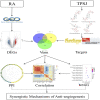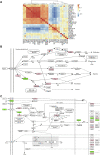Computational Prediction of Antiangiogenesis Synergistic Mechanisms of Total Saponins of Panax japonicus Against Rheumatoid Arthritis
- PMID: 33324204
- PMCID: PMC7723436
- DOI: 10.3389/fphar.2020.566129
Computational Prediction of Antiangiogenesis Synergistic Mechanisms of Total Saponins of Panax japonicus Against Rheumatoid Arthritis
Abstract
Objective: To investigate the anti-angiogenesis mechanisms and key targets of total saponins of Panax japonicus (TSPJ) in the treatment of rheumatoid arthritis (RA). Methods: RStudio3.6.1 software was used to obtain differentially expressed genes (DEGs) by analyzing the differences in gene expression in the synovial tissue of RA and to predict the potential targets of active compounds from TSPJ by the PharmMapper and SwissTargetPrediction databases. We evaluated the overlapping genes by intersectional analysis of DEGs and drug targets. Based on the overlapping genes, we used Cytoscape 3.7.2 software to construct a protein-protein interactions (PPI) network and applied Kyoto Encyclopedia of Genes and Genomes (KEGG) analysis to determine the mechanisms of the treatment. Finally, the correlations with angiogenesis-related genes were explored. Collagen-induced arthritis (CIA) model was established and treated with different doses of TSPJ. The manifestations of CIA were determined by evaluation of arthritis index and histology score. Serum levels of vascular endothelial growth factor (VEGF) and the hypoxia-inducible factor 1 (HIF-1) were tested by ELISA. The mRNA levels of IL-1β and IL-17A were detected by real time-quantitative PCR. Results: Altogether, 2670 DEGs were obtained by differential analysis, and 371 drug targets were predicted for four active components (Araloside A, Chikusetsusaponin IVa, Ginsenoside Rg2, and Ginsenoside Ro). A total of 52 overlapping genes were included in the PPI network and the KEGG analysis. However, only 41 genes in the PPI network had protein interactions. The results of the KEGG enrichment analysis were all related to angiogenesis, including VEGF and HIF-1 signaling pathways. Seven genes with negative correlations and 16 genes with positive correlations were obtained by correlational analysis of DEGs in the VEGF and HIF-1 signaling pathways. SRC proto-oncogene, nonreceptor tyrosine kinase (SRC), and the signal transducer and activator of transcription 3 (STAT 3) had a higher value of degree and showed a significant correlation in the pathways; they were regarded as key targets. Compared with the model group, TSPJ significantly relieved the symptoms and decreased the expression of VEGFA, HIF-1α, IL-1β, and IL-17A in serum or spleens of CIA mice. Conclusion: In the current study, we found that antiangiogenesis is one of the effective strategies of TSPJ against RA; SRC and STAT 3 may be the key targets of TSPJ acting on the VEGF and HIF-1 signaling pathways, which will provide new insight into the treatment of RA by inhibiting inflammation and angiogenesis.
Keywords: Panax japonicus; angiogenesis; network pharmacology; rheumatoid arthritis; saponins.
Copyright © 2020 Guo, Ji, Jose Kumar Sreena, Hou, Luo, Fu, Mei and Feng.
Figures






Similar articles
-
The antiangiogenic effect of total saponins of Panax japonicus C.A. Meyer in rheumatoid arthritis is mediated by targeting the HIF-1α/VEGF/ANG-1 axis.J Ethnopharmacol. 2024 Oct 28;333:118422. doi: 10.1016/j.jep.2024.118422. Epub 2024 Jun 3. J Ethnopharmacol. 2024. PMID: 38838922
-
Anti-inflammatory and osteoprotective effects of Chikusetsusaponin Ⅳa on rheumatoid arthritis via the JAK/STAT signaling pathway.Phytomedicine. 2021 Dec;93:153801. doi: 10.1016/j.phymed.2021.153801. Epub 2021 Oct 14. Phytomedicine. 2021. PMID: 34758437
-
Curative effect of the total saponins of Panax japonicus (TSPJ) on type 2 diabetes: Focusing on VEGFA.Gene. 2024 May 30;909:148305. doi: 10.1016/j.gene.2024.148305. Epub 2024 Feb 23. Gene. 2024. PMID: 38403172
-
Hypoxia-inducible factor-1 as regulator of angiogenesis in rheumatoid arthritis - therapeutic implications.Curr Med Chem. 2010;17(3):254-63. doi: 10.2174/092986710790149783. Curr Med Chem. 2010. PMID: 20214567 Review.
-
Inhibiting Angiogenesis by Anti-Cancer Saponins: From Phytochemistry to Cellular Signaling Pathways.Metabolites. 2023 Feb 22;13(3):323. doi: 10.3390/metabo13030323. Metabolites. 2023. PMID: 36984763 Free PMC article. Review.
Cited by
-
Diversity and Isolation of Endophytic Fungi in Panax japonicus and Biotransformation Activity on Saponins.Curr Pharm Biotechnol. 2024;25(9):1199-1208. doi: 10.2174/0113892010247700230919053439. Curr Pharm Biotechnol. 2024. PMID: 37767797
-
Network Pharmacology and Molecular Docking Study of the Chinese Miao Medicine Sidaxue in the Treatment of Rheumatoid Arthritis.Drug Des Devel Ther. 2022 Feb 19;16:435-466. doi: 10.2147/DDDT.S330947. eCollection 2022. Drug Des Devel Ther. 2022. PMID: 35221674 Free PMC article.
-
Anti-Arthritic Effect of Edaravone Against Complete Freund Adjuvant Induced Arthritis via Osteoclast Differentiation and HIF-1α-VEGF-ANG-1 Axis.Drug Des Devel Ther. 2023 Feb 18;17:519-534. doi: 10.2147/DDDT.S391606. eCollection 2023. Drug Des Devel Ther. 2023. PMID: 36845667 Free PMC article.
-
Molecular Mechanism of Yangshen Maidong Decoction in the Treatment of Chronic Heart Failure based on Network Pharmacology, Molecular Docking, and Molecular Dynamics Simulations.Cell Biochem Biophys. 2024 Jun;82(2):1433-1451. doi: 10.1007/s12013-024-01297-7. Epub 2024 May 16. Cell Biochem Biophys. 2024. PMID: 38753250
-
Systematic pharmacology-based strategy to investigate the mechanism of beta-sitosterol for the treatment of rheumarthritis.Front Genet. 2024 Dec 4;15:1507606. doi: 10.3389/fgene.2024.1507606. eCollection 2024. Front Genet. 2024. PMID: 39698463 Free PMC article.
References
LinkOut - more resources
Full Text Sources
Research Materials
Miscellaneous

